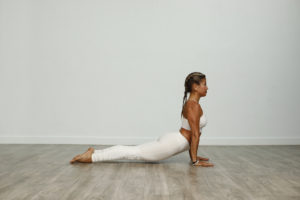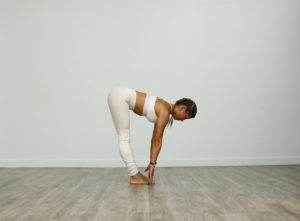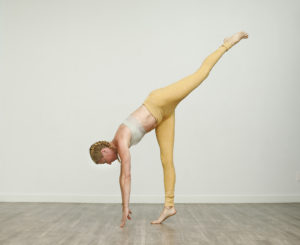What exactly is the difference between slow flow and vinyasa? When you’re looking for online yoga, it’s important to understand the different styles of classes. On yourBuddhi we have tons of slow flow and vinyasa, along with kundalini and some meditation classes. Once you figure out how they differ from each other, it will be easier to choose a class that is right for how you feel in the moment. One day you might want the physical challenge of a vinyasa class while on another day you’ll want the slow and steady pace of a slow flow.
Vinyasa Often Has a Quicker Pace
 Vinyasa does not mean fast. However many vinyasa teachers do pick up the pace in order to make it more challenging. Often there is fun and energetic music in the background that will fuel this quicker pace. As long as students are able to keep the breath at a steady rate through the nose, it’s okay to move a little faster. It’s a great way to burn off excess energy and in turn calming the nervous system. Some people need to move consistently and rapidly to get to a peaceful state of mind. The pace of many vinyasa classes are great for this.
Vinyasa does not mean fast. However many vinyasa teachers do pick up the pace in order to make it more challenging. Often there is fun and energetic music in the background that will fuel this quicker pace. As long as students are able to keep the breath at a steady rate through the nose, it’s okay to move a little faster. It’s a great way to burn off excess energy and in turn calming the nervous system. Some people need to move consistently and rapidly to get to a peaceful state of mind. The pace of many vinyasa classes are great for this.
Slow Flow classes are a bit slower. They leave tons of time and space for long, deep breaths and slow, steady transitions. At Buddhi, slow flow classes are actually a style of vinyasa. This is because the sequence is smooth and connected with breath to movement connection. However there is more opportunity to hold things for a longer time and breathe within the postures. The time spent in the poses is usually longer so that students can familiarize themselves with all the different poses.
Poses Are More Simple In Slow Flow
 There are so many different yoga poses! It’s an endless selection with varying intensity. Some poses require tons of strength and flexibility, while many others are very accessible to a wide range of people. The poses in a slow flow class are more accessible. Slow flow is a great class for beginners so teachers tend to keep things simple. Teach the most basic postures so that students understand the foundation of all the different types of poses. Postures fall into different classifications such as standing, backbends, forward folds, inversions, hip openers, arm balances and twists. Teachers can teach the more basic variations from every single group in a slow flow class. So it’s a very well-rounded experience that a wide variety of people will feel comfortable in.
There are so many different yoga poses! It’s an endless selection with varying intensity. Some poses require tons of strength and flexibility, while many others are very accessible to a wide range of people. The poses in a slow flow class are more accessible. Slow flow is a great class for beginners so teachers tend to keep things simple. Teach the most basic postures so that students understand the foundation of all the different types of poses. Postures fall into different classifications such as standing, backbends, forward folds, inversions, hip openers, arm balances and twists. Teachers can teach the more basic variations from every single group in a slow flow class. So it’s a very well-rounded experience that a wide variety of people will feel comfortable in.
Postures in vinyasa classes range from simple to more advanced. Vinyasa teachers will also take postures from every single group in a class. The body gets very warm and open during the warm-up portion of a vinyasa class. People are sweating and feeling flexible and ready to try some wild things. The body is well prepared to go for more challenging poses. This is one of the reasons that people say that vinyasa is more “advanced” than slow flow. But this is true only in the sense of accomplishing physical feats. Someone used to moving quickly in a vinyasa class with high expectations of pushing their limits might find it extremely mentally challenging to slow down enough for a slow flow class. It could also be said that the patience and focus that is developed from going to slow flow classes is even more advanced than being able to do the fancy physical stuff.
Vinyasa Classes Have Trickier Transitions
 Both vinyasa and slow flow classes have smooth transitions between poses. The position of one pose is set up to flow easily into the next, like a dance. This feels very good and is extremely calming to the nervous system. It’s as if the breath is a wave your are riding and the body is the surfboard. It’s one of the main reasons that people love these yoga classes, whether they realize it or not. Smooth transitions can be simple and easy, intricate and complex, and everything in between.
Both vinyasa and slow flow classes have smooth transitions between poses. The position of one pose is set up to flow easily into the next, like a dance. This feels very good and is extremely calming to the nervous system. It’s as if the breath is a wave your are riding and the body is the surfboard. It’s one of the main reasons that people love these yoga classes, whether they realize it or not. Smooth transitions can be simple and easy, intricate and complex, and everything in between.
The transitions in slow flow classes tend to be on the simple and easy side. For example, in a vinyasa class, the teacher will have students step the foot to the front of the mat from a downward dog position. For experienced vinyasa practitioners, this is a great transition. It sets the body up to be able to flow from one standing sequence to the next in a dancelike flow. However it’s a difficult move for a lot of people, especially for beginners or students with less mobility. It can actually be extremely frustrating. This is not what we are going for, we don’t want students to be frustrated. So in slow flow, teachers ask students to step back into standing poses from the front of the mat. It still requires focus, coordination and flexibility, just not quite as much. So vinyasa classes, while their transitions are very smooth, are usually much trickier than those in a slow flow.
Slow Flow or Vinyasa?
If you’re more of a beginner or say things like “I’m too stiff to do yoga,” then try our slow flow classes. If you’re looking for more physical exertion and a good sweat, go for vinyasa or our Buddhi Flow classes. There is no hierarchy, slow flow is not a stepping stone to vinyasa. They are just different and now you know why. And if you’re still confused on which way to go, then you’ll probably love both! So try a bunch of different classes to find what you like.

Leave a Reply
You must be logged in to post a comment.